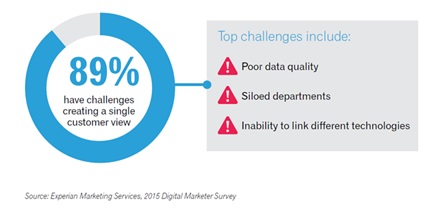The following column was originally published in Adotas.
Addressing the issue of identity management has become a top priority for marketers. The fact is that their customers are represented by dozens of identities – both known and unknown – in today’s digital world.
According to new research published in our recently published 2015 Digital Marketer Report, linking identity data is now the #1 challenge for marketers around the world, up from fourth place just a year ago. Further, 89% of marketers report having challenges creating a single customer view.
Why? Top reasons cited by marketers include poor data quality (43%), siloed departments (39%), and inability to link different technologies (37%).

Brand marketers have an identity crisis
Without a sophisticated approach to identity management, the concept of customer-centricity and data-driven marketing slips, like sand, through the fingers of marketers. Yes, they may have details around a specific customer on a given device or in a particular channel, but the holistic promise provided by identity data is lost; and with it the real potential of targeting, reaching and engaging digital audiences.
To appreciate the nature of the challenge, it is helpful to understand its scale. According to our latest research, 84% of U.S. adults are digital. Seventy three percent own a computer, 58% a smart phone and 33% a tablet – percentages that will only increase with time.
These devices will be joined by wearables (such as the Apple Watch), addressable television and the emerging world of the Internet of Things. Couple the explosion of devices with the number of email addresses, social media accounts, apps, website logins, cookies and other trackers and you have the ingredients for a full-blown identity crisis.

Connecting the identity dots
All of the data associated with these identities paint a rich, complex and complete picture of the user behind them. Connecting and managing these identity dots, however, is no small task. For everyone there are known identities (accounts you log into) and unknown ones (anonymous IDs based on web histories) and marketers need to appreciate and be able to navigate the differences.
When linked and analyzed responsibly, identity information allows marketers to understand who we are, what matters to us and how to craft the most effective digital experience for all. This is what makes identity management such a critical issue.
Good identity data provides marketers with three core capabilities:
Identify – the ability to identify people across media channels, devices, access methods and applications using techniques including cookies, deterministic and probabilistic IDs and first party data.
Link – the ability to link disparate data and profiles into a unified consumer view.
Engage – the ability to use a deeper understanding of customers to better deliver better messages, optimize campaigns and measure performance.
Identity Management is the foundation of Data-Driven Marketing
For marketers to get the greatest benefit from their data, they need an identity management strategy that considers and addresses the following three things:
Data Stewardship – preserving the value of the information, protecting the privacy of individuals and making it available for appropriate uses.
Identity Resolution – having the ability to make connections between disparate known datasets and being able to infer connections between known and unknown identities.
Technology-Current – maintaining the ability to effectively and compliantly collect, manage and act on digital identity-derived information across existing and emerging channels, platforms and devices.
So what does this identity management approach look like in a real world campaign?
A customer visits a brand website, uses its mobile app and “like” it on Facebook. The result is three discreet identifiers, two deterministic (the app and Facebook) but likely stored in separate systems and one statistical (the site visit). Appropriate data stewardship means all three data sets are stored and protected – and, perhaps most importantly – are accessible.
Although a distinct identifier represents each of the three identities, linkage capabilities allow them to be resolved in a way that unites the data behind each of the three. Rather than treating each identifier as a separate individual, they can now be used to reflect different facets on a single person.
With a now unified view, the marketer can begin to plan to reach their customers in more creative and effective ways. They can do a better job of executing cross-channel campaigns – and frequency capping on all devices and platforms. This provides a dramatically different experience for all involved. Why? Because not only does the marketer have a unified view of the customer, but the customer has a unified experience of the brand.
Without an identity-driven approach to audience engagement and marketing, the customer will not be able to have a unified brand experience because the marketer can’t establish that unified view. Further, it allows marketers to make the most of their organization’s information assets, meet their customers where and when it makes the most sense and execute the most cost-efficient and effective campaign possible.